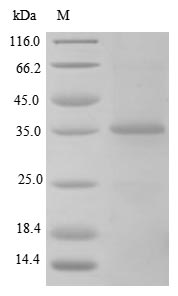Recombinant Rat Transforming growth factor beta-1 proprotein (Tgfb1) is expressed in E. coli with an N-terminal 6xHis-tag for easy purification. The protein includes the amino acids 30-278, representing a partial sequence of the full-length protein. This product achieves a purity greater than 85% as verified by SDS-PAGE, making it suitable for various laboratory applications. It is offered for research use only and not for diagnostic or therapeutic purposes.
Transforming growth factor beta-1 (TGF-beta1) appears to be one of the more crucial cytokines involved in regulating cell growth, differentiation, and immune responses. Part of the broader TGF-beta superfamily, it likely plays significant roles in cellular processes and participates in numerous signaling pathways. Scientists have extensively studied TGF-beta1 for its impact on fibrosis, wound healing, and immune system modulation, which may explain why it has become a key focus across various research areas.
Potential Applications
Note: The applications listed below are based on what we know about this protein's biological functions, published research, and experience from experts in the field. However, we haven't fully tested all of these applications ourselves yet. We'd recommend running some preliminary tests first to make sure they work for your specific research goals.
Tgfb1 is a complex cytokine that requires precise folding, disulfide bond formation, and proteolytic processing for activation. The E. coli expression system cannot perform the necessary post-translational modifications (particularly proper disulfide bonding) or the proteolytic cleavage required to generate active Tgfb1. This recombinant Tgfb1 protein represents only a partial proprotein fragment (30-278aa) and lacks the latency-associated peptide (LAP) and mature Tgfb1 domains needed for functionality. Therefore, this protein is highly unlikely to be correctly folded or biologically active.
1. Antibody Development and Validation Studies
This recombinant Tgfb1 proprotein fragment serves as a suitable immunogen for generating antibodies against linear epitopes of the rat Tgfb1 proprotein region. The defined sequence (30-278aa) allows for targeted antibody production. However, antibodies may not efficiently recognize conformational epitopes on the properly processed, mature Tgfb1 found in biological systems.
2. Biochemical Characterization and Stability Studies
This is the essential first step to assess the physical properties of this specific protein preparation. Techniques like size-exclusion chromatography and circular dichroism can evaluate oligomeric state, homogeneity, and secondary structure content. These studies provide critical quality control data but characterize a misfolded fragment, not the native protein.
3. Comparative Species Analysis
This protein can be used for sequence-based comparisons and immunological cross-reactivity studies between species. However, functional comparative studies (e.g., receptor binding affinity, bioactivity comparisons) would be invalid due to the protein's misfolded state and lack of proper processing.
Final Recommendation & Action Plan
This recombinant Tgfb1 proprotein fragment is fundamentally unsuitable for functional studies due to E. coli's inability to produce properly folded and processed Tgfb1. The recommended approach is to prioritize Application 2 (Biochemical Characterization) to understand the physical properties of this specific reagent. Application 1 (Antibody Development) can proceed confidently for generating proprotein region-specific antibodies. This protein is useful for structural and immunological comparisons but not for functional studies requiring active Tgfb1. Tgfb1 interactions require precise tertiary structure and proper processing that this misfolded, partial fragment cannot provide. For functional Tgfb1 studies, use mature Tgfb1 from mammalian expression systems or commercially available active Tgfb1.






